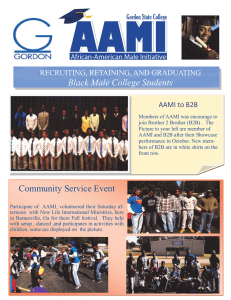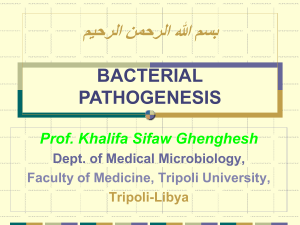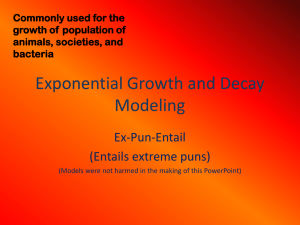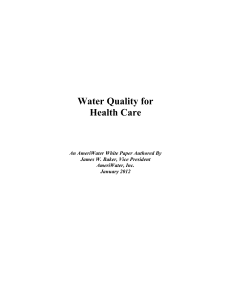Dialysis Water Treatment Systems
advertisement
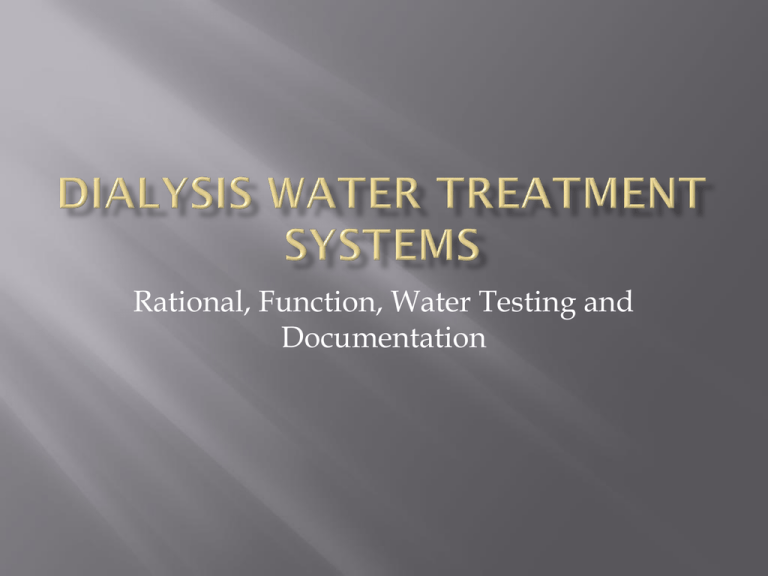
Rational, Function, Water Testing and Documentation AAMI (Association for the Advancement of Medical Instrumentation) since 1982 has set the standards for all Hemodialysis Equipment, Water Treatment, Hemodialysis Concentrates and Hemodialyzer Reprocessing AAMI states that the medical director has ultimate responsibility for the water treatment system and all testing and performance of that system Water Treatment Systems installed after May 30,1997 must are subject to the FDA 510(k) approval process It is imperative that a dialogue be maintained with the feedwater suppliers Hemodialysis Water Treatment Standards are an evolutionary process dictated by data and information gathered on the effects of water on patient mortality and morbidity. Sadly many patients have died over the years as a result of ignorance, carelessness , bad luck and the failure to follow the standards then in effect. Education of all members of the dialysis treatment team will allow us to be more cognizant of the dangers involved in the treatment process, and encourage us to do our best for our patients Mixes hot and cold water to maintain a constant temperature of 77 F or 25 C This prevents harm to patients and damage to the RO (reverse osmosis ) membranes Product water output will decrease as the temperature decreases A temperature gauge is placed downstream and is monitored Blending Valve and Booster Pump Maintains a constant flow and pressure to the Pretreatment components and the RO Pressure gauges are placed before and after the pump and are monitored Filters larger particles from the feedwater This protects the downstream pretreatment equipment and the RO This system is routinely backwashed at night by the use of an automatic timer and is connected to the RO with lockout protection Pre and post pressure gauges are used and monitored Sediment Filter Removes Calcium and Magnesium from the feedwater to prevent scaling on the Carbon filters and the RO An ion exchange resin is used that attracts Calcium and Magnesium and releases a Sodium ion The softener is regenerated at night by an automatic timer and is connected to the RO with lockout protection Pre and post pressure gauges are used and monitored Water hardness testing is done and documented at the beginning and end of the treatment day Water Softener Removes chlorine, chloramines and organic compounds by the use of GAC (granular activated charcoal) Two tanks in series are used Feedwater must contact the carbon for a EBTC (empty bed contact time) of at least 10 minutes The carbon cannot be regenerated, but a flushing is done at night with an automatic timer Pre and post pressure gauges are used and monitored Chlorine and chloramine testing must done and documented before each patient treatment Carbon Filters Purifies large volumes of relatively pure water at low cost Usually has a 5 micron filter that removes carbon fines and resin beads Water pump forces pretreated water at high pressure through semi-permeable membranes Efficiently removes > 95% of ions Removes bacteria but not endotoxins Has alarm system to protect patient RO Data Sheet Deionization is generally used as a backup in case of RO failure Most systems use a dual bed (cation and anion) system of ion exchange resins Produces water purer than a RO but is very expensive Does not remove bacteria or endotoxins Must be regenerated offsite from vendors that deal with medical or food grade systems Resistivity must be continuously monitored to 1 megohm with an audible and visual alarm in patient area and a product stop or divert Used to remove bacteria and endotoxins from product water Required downstream from a DI system Used to control bacteria in a water storage and distribution system The intensity of the UV light must be monitored and alarmed (visual) to insure sufficient kill intensity Ultrafilters are recommended downstream from the UV light Water storage tanks are used when a direct feed system isn’t feasible or recommended Must have a conical bottom, tight fitting lid and a hydrophobic 0.2 micron air filter The recirculating pumps run 24/7 to keep bacteria from forming on the walls of the tank and in the The water flow velocity must be at least 3 feet per second (1.5 feet per second for direct feed) RO Water Storage AAMI Chemical Analysis A test of 21 chemical contaminants performed at least once a year ,and when there are feed water changes. See AAMI standards for limits Bacteria Colony counts Performed monthly per AAMI standards Action Level > 50 CFU/mL Maximum Level 200 CFU/mL LAL Endotoxin Performed monthly per AAMI standards Action Level > 1.0 EU/mL Maximum Level 2.0 EU/mL An Action process must de developed to deal with the situation when limits for any water tests are exceeded Chemical Contaminants, Bacteria Colony Counts and LAL Endotoxin should be consolidated to allow for trend analysis and government audits A Water Treatment System Log should include but not limited to data from all pressure and temperature gauges, RO data screen, post softener hardness results, brine tank inspection and action, chloramine test results and any action, filter change, cultures performed, cleaning and/or disinfection completed on the water treatment system (see handouts)


